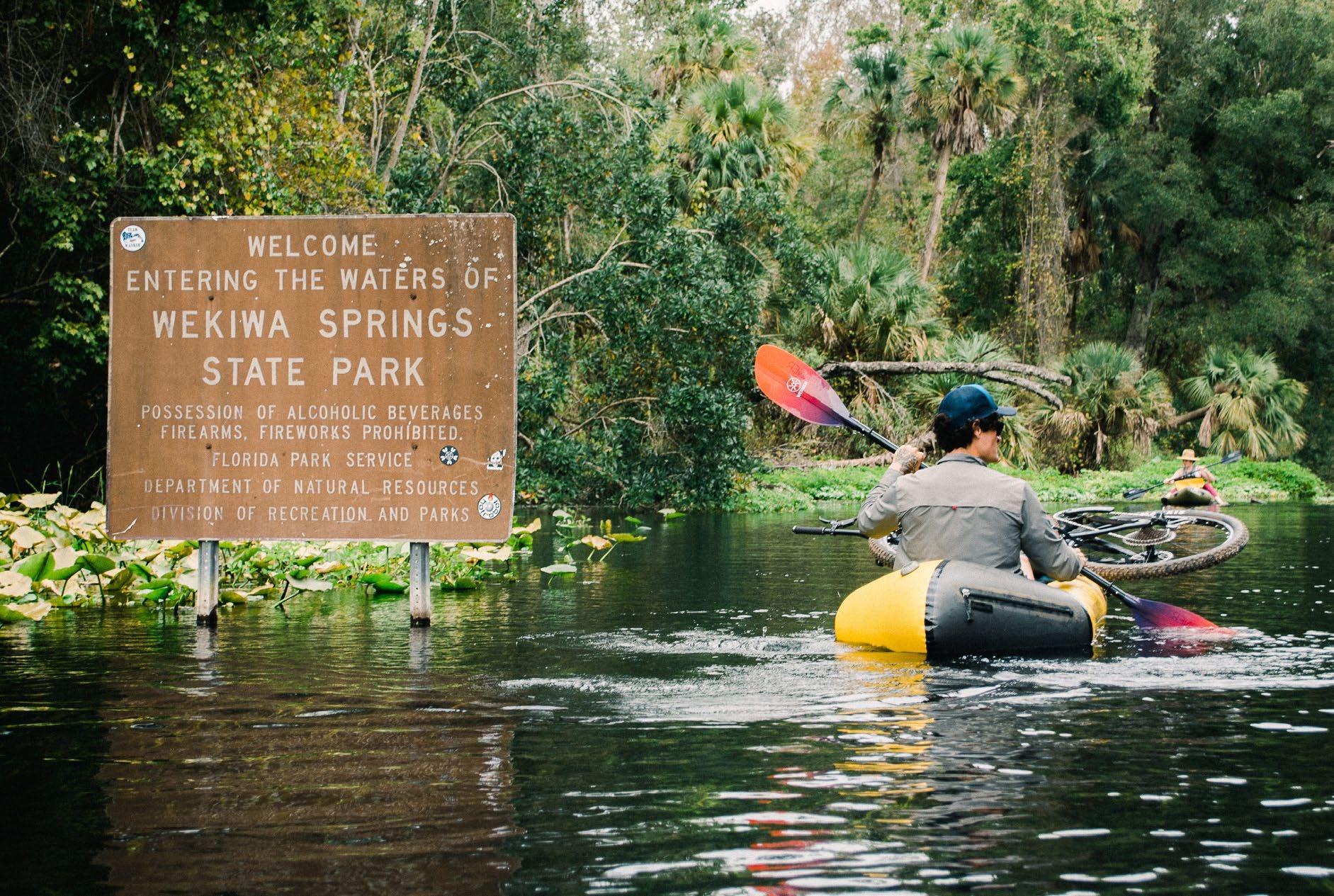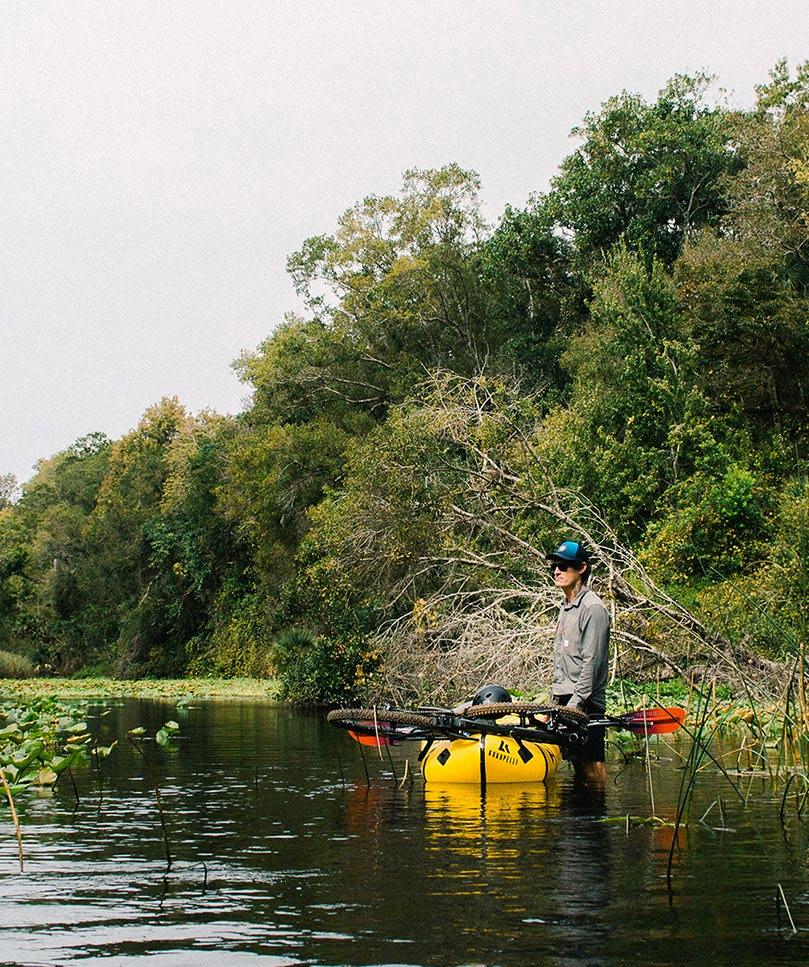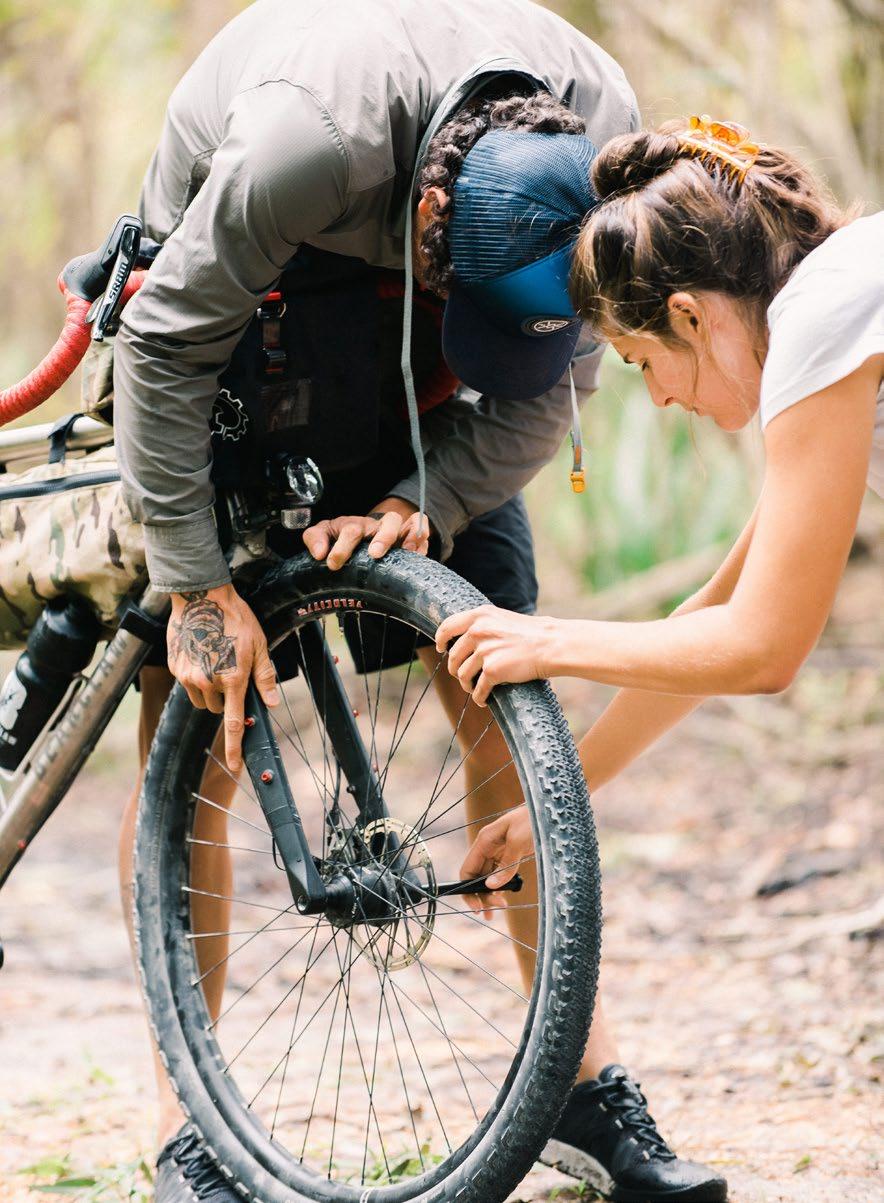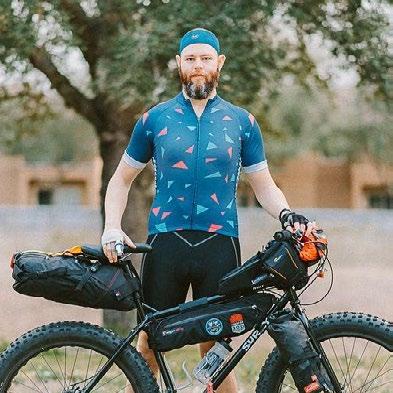
7 minute read
BIKERAFTING WEKIVA STATE PARK
from Wild Traverse
Florida, USA
Written by Abby Scott / Images by David Childers
Advertisement
As kids growing up in Florida, my friends and I spent hazy summer days paddling along its murky rivers and dipping into the cool spring waters, which always remain at a blessed 72 degrees. We passed winters lounging on docks in warm jackets with our feet dangling over chilly, dark lakes.
Water connects Floridians, with each other and with the nature around us. The state is one massive landmass, buoyed just above the water table by pockmarked limestone. Bad storms are almost always a blessing in disguise, at first bringing floods, ripping up trees, and causing even worse traffic but also simultaneously replenishing and refueling a sensitive yet resilient ecosystem. Floridians don’t much mind weathering a few storms.
After living in the desert for years, my roots longed for a drink of the sunshine state’s tea-colored waters and thankfully this fall, I received the chance to packraft a beloved childhood summer swimming hole - Wekiva Springs. As a kid, I loved swimming in Wekiva’s crystal clear water. End of the year parties took place under cabanas and, after filling up on watermelon and potato chips, we sprinted towards the natural pool, goggles in hand ready to explore a new world just below the surface.
I presumed that Wekiva Springs would present differently to the adult version of me — its water less sparkly, probably packed with sunburnt tourists bobbing up and down in inner tubes. But, to my surprise, when I returned for the first time this fall, it wasn’t any less magical than it had been in my memories. In fact, the lily pads looked greener, the water was more turquoise, and wildlife abounded. I suddenly appreciated it a thousand times more than when I was eleven. It’s true, you really don’t know what you have until it’s gone.

Wekiva is a world apart from its suburban surroundings. The spring attracts visitors, tourists, and locals year-round with summertime as its peak season — the state park often reaches maximum occupancy before the first mosquito wakes up. We didn’t plan on lingering too long in the main spring but instead we wanted to get away from the crowds and packraft the calm, meandering Wekiva River.
The headwaters of the Wekiva River begin at the confluence of Wekiva Spring Run and Rock Springs Run, an integral flow-way in the Wekiva River system. Clear spring water bubbles up from a natural limestone aquifer and courses through state-owned scrub forests until it joins flowing water from Wekiva Springs. In 2000, the US Congress designed the Wekiva River as a “National Wild and Scenic River” — its ecosystem boasts five “Outstandingly Remarkable Values” including water quality, cultural resources, and wildlife habitat. Because of this designation, the waterway has been and will be protected in perpetuity so that it may continue to resemble what the state’s indigenous tribes experienced centuries ago.
The Rock Springs Run is gentle enough to bring a bike and its packed-dirt trails link various take out points with main roads, making it the perfect place for a bikerafting day trip. My packrafting partner is also a native Floridian and we both craved a way to experience our home state’s wetland ecosystem and diverse, canopied forests — bikerafting more than fit the bill.
Our packrafting crew - consisting of Andrew, David, Emily, and myself - parked at King’s Landing, a local canoe and kayak rental shop nine miles up from the usual take out, a local, riverside watering hole and hang out, Wekiva Island. The October weather was perfect — overcast and cool with no storms on the horizon, meaning we’d have plenty of time to go slow along the Rock Springs Run.
After each inflating our XPD and Rogue-lite packrafts, we removed the front tires of our bikes and strapped the entire set up to the bow. Gingerly carrying our rigs to the water’s edge, conversation about the possibility of gator sightings flowed nervously between us. We strapped our PFDs on and launched into the narrow channel of the flow-way. Within 100 yards, we hit a fork in the river and turned left to continue downstream. The river was flowing slowly, at an estimated 1 mph, so we let our paddles rest as we scanned for native birds amongst the lush foliage lining the river’s natural banks.

The first stretch of the run passes along the backyards of Florida bungalows, precariously placed at sea level and prone to flooding should a torrential downpour arrive. Earth-toned homes blended in with the background while colorful cottages popped out from the greenery. The next few miles gave way to a beautiful narrow channel that drifted lazily through bald cypress, cabbage palms, and hickory trees.
At around the two-mile mark, we came round the bend and spotted a 5-foot gator slithering from the bank into the carmel water, never to be seen again, or so we hoped. On sunny days, paddlers may spy alligators along this stretch of river, perched on logs and sprawled on beaches gathering rays. They keep to themselves and are more scared of humans than we are of them.

Certain sections of the float were shallow and clogged with gnarled branches and downed trees, making the paddle even more prehistoric and adventuresome. Fortunately, the durable material of the XPD allowed us to bump over roots, logs, and shallow bottoms, so Emily and I paddled ahead to scout for Andrew and David’s lighter-weight Rogue-lites. At certain points along Rock Springs Run, the water clears up and paddlers can see clear to its sandy bottom. We pulled off and waded in, our senses completely immersed in the natural surroundings.



We hopped back in our packrafts and passed fellow paddlers fishing for the day’s catch under water-logged branches or in collections of pennywort. As we neared the take out, we came upon a tall sabal palm, growing sideways from the shore and creating the perfect bridge for us to pass under. It was a lovely salute to a beautiful day on the water.


- ANDREW DURAN
We pulled up to Big Buck campsite and took out our packrafts. We quickly unstrapped our bikes, easily reassembling them. After rolling our packrafts and strapping them on the handlebars, we peddled up the sandy path towards the main trail. The next five miles varied from a hard-packed, narrow dirt trail to sandy, wide pathways, each easy to peddle. Florida’s twisted live oaks and sturdy cabbage palms created a thick patchwork of foliage and was disorienting at times. It’s easy to get lost in the flat, dense Florida forest. Wekiva’s trail system is well marked and the lack of hills were a blessed reprieve from our normal western biking excursions. After an hour’s ride we ended up at our destination, Wekiva Island.

Exploring the Wekiva River river system gave me a taste of what Florida was like before settlers arrived — wild and remarkable, a balance between chaos and mother nature’s grand design. Florida’s visitors and residents alike may experience the state’s myriad inland waterways and wild, exotic landscape from the seat of a packraft. Throw it in the trunk or pack it in your carry on to get the gift of unbridled access to a land born from the belly of the swamp, resilient and resistant despite rapid change, waiting to take back what rightfully belongs to it.

David Childers is a professional photographer who loves creating stories with his images. He lives in Orlando, FL with his wife Evan who's a pastry chef at Walt Disney World. @DChildersPhoto@DChildersPhoto

Abby Scott enjoys crafting captivating stories to inspire fellow readers to chart their own adventures outside. She currently lives full time out of her van, giving her the freedom to explore the most remote and stunning locations. @AbbyLouScott






